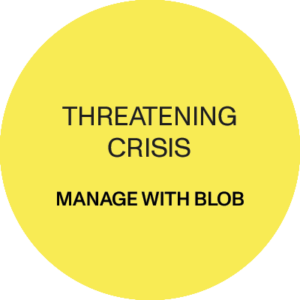Threatening crisis signifies a situation with the potential to cause serious harm, disruption or damage to an organization.
It poses a significant risk to its operations, reputation or stakeholders.
Effective crisis management involves swift and strategic responses to mitigate the impact, safeguard assets and restore confidence.
Threatening crisis handling requires clear communication, proactive measures and decisive leadership to navigate and overcome the challenges it presents.
Personalized Progress Disclaimer. Embarking on a journey to enhance your professional presence can feel like a significant undertaking. We want to assure you that our approach is tailored to your pace, ensuring a smooth and comfortable experience. Our collaborative process begins with an exploration of your goals, and together, we navigate the learning curve at a speed that suits you. Your progress is the compass, and we are here to guide you, ensuring a relaxed and uplifting journey. You can trust that every step is orchestrated to align with your comfort, ensuring a positive and manageable path towards achieving your business aspirations.

By following these strategies, we can effectively assist a client in managing a threatening crisis, minimizing damage to the client’s reputation and facilitating a swift and strategic recovery. The key is a proactive approach, effective communication and continuous evaluation to refine crisis management strategies for the future:
CRISIS PREPAREDNESS:
- Risk Assessment: conducting a thorough risk assessment to identify potential crises that the client may face. Anticipating scenarios and assessing their potential impact on the client’s reputation
- Crisis Communication Plan: collaborating with the client to develop a comprehensive crisis communication plan. Defining roles and responsibilities, establishing communication protocols and outlining response strategies for different scenarios
- Spokesperson Training: providing media training for key spokespeople within the client’s organization. Ensuring they are well-prepared to handle media inquiries, maintain composure and convey key messages effectively during a crisis
- Social Media Monitoring: implementing robust social media monitoring tools to track online conversations and identify potential issues before they escalate. Prompt detection is crucial for early intervention
- Notification Systems: establishing internal notification systems to ensure that key stakeholders are informed promptly in the event of a crisis. This includes internal teams, leadership and relevant external parties
CRISIS RESPONSE:
- Immediate Response Team Activation: activating the crisis response team immediately when a threatening situation arises. Ensuring clear lines of communication and coordination among team members
- Assessment and Information Gathering: gathering accurate and timely information about the crisis. Assessing the severity, scope and potential impact before formulating a response strategy
- Legal Consultation: engaging legal experts to provide guidance on potential legal implications and considerations associated with the crisis. Ensuring that responses align with legal requirements
- Drafting Statements and Messaging: collaborating on drafting clear and consistent statements and messaging. Messages should convey transparency, accountability and commitment to resolving the issue
- Media Relations Strategy: developing a media relations strategy to manage external communications. Determining when, how and what information should be shared with the media to maintain control over the narrative
CRISIS COMMUNICATION:
- Proactive Media Engagement: proactively engaging with the media to share the client’s perspective on the crisis. Scheduling press conferences, interviews or briefings to present key messages directly
- Online Reputation Management: implementing online reputation management strategies to address negative narratives circulating on social media and other online platforms. Responding promptly to misinformation and engage with concerned stakeholders
- Stakeholder Communication: developing targeted communication for different stakeholder groups, including customers, employees, investors and regulatory bodies. Tailoring messages to address specific concerns and provide reassurance
- Regular Updates: providing regular updates to stakeholders and the public as the crisis unfolds. This helps maintain transparency and demonstrates a commitment to addressing the issue
AFTERMATH AND EVALUATION:
- Post-Crisis Assessment: conducting a thorough post-crisis assessment to evaluate the effectiveness of the response. Identifying strengths, weaknesses and areas for improvement in crisis management
- Learning and Adaptation: learning from the crisis experience and adapting crisis communication plans and strategies accordingly. Updating protocols based on lessons learned to enhance future crisis preparedness
- Reputation Repair: working on reputation repair by implementing strategic communication initiatives. Showcasing corrective actions, improvements and a renewed commitment to stakeholders
- Monitoring and Analysis: continuously monitoring media coverage and stakeholder sentiment post-crisis. Analyzing data to gauge the success of reputation recovery efforts and address any lingering issues
LEGAL AND REGULATORY COMPLIANCE:
- Compliance Monitoring: monitoring legal and regulatory developments related to the crisis. Ensuring ongoing compliance with relevant laws and regulations throughout the crisis management process
- Documentation and Reporting: maintaining thorough documentation of all actions taken during the crisis. This includes communication exchanges, legal consultations and internal decision-making processes. Preparing comprehensive reports for regulatory authorities as necessary

Pricing. Our pricing structure is designed with modularity in mind, ensuring that you only pay for the services you require, allowing for flexibility and customization. For each task you may decide to delegate to us there is a prewritten full-service list. This list consists of basic must do services, extent of available optional added services and suggestion of optional added third party services. During our task related Initial Chat, in a direct conversation with the client, we choose a customized list of services as per clients’ needs and circumstances. To accommodate different difficulty levels, we introduce an index for difficulty. The basic price is multiplied by this index to calculate the price for a task at any difficulty level, ensuring a fair and flexible pricing model that accurately reflects the complexity of the services provided. The level is argumented and agreed upon during the task related Initial Chat. With these inputs we then prepare and deliver to client our exact offer. For client’s information and potential budget range idea we have provided, for each task, a task price list as .pdf file with relevant details disclosed.

